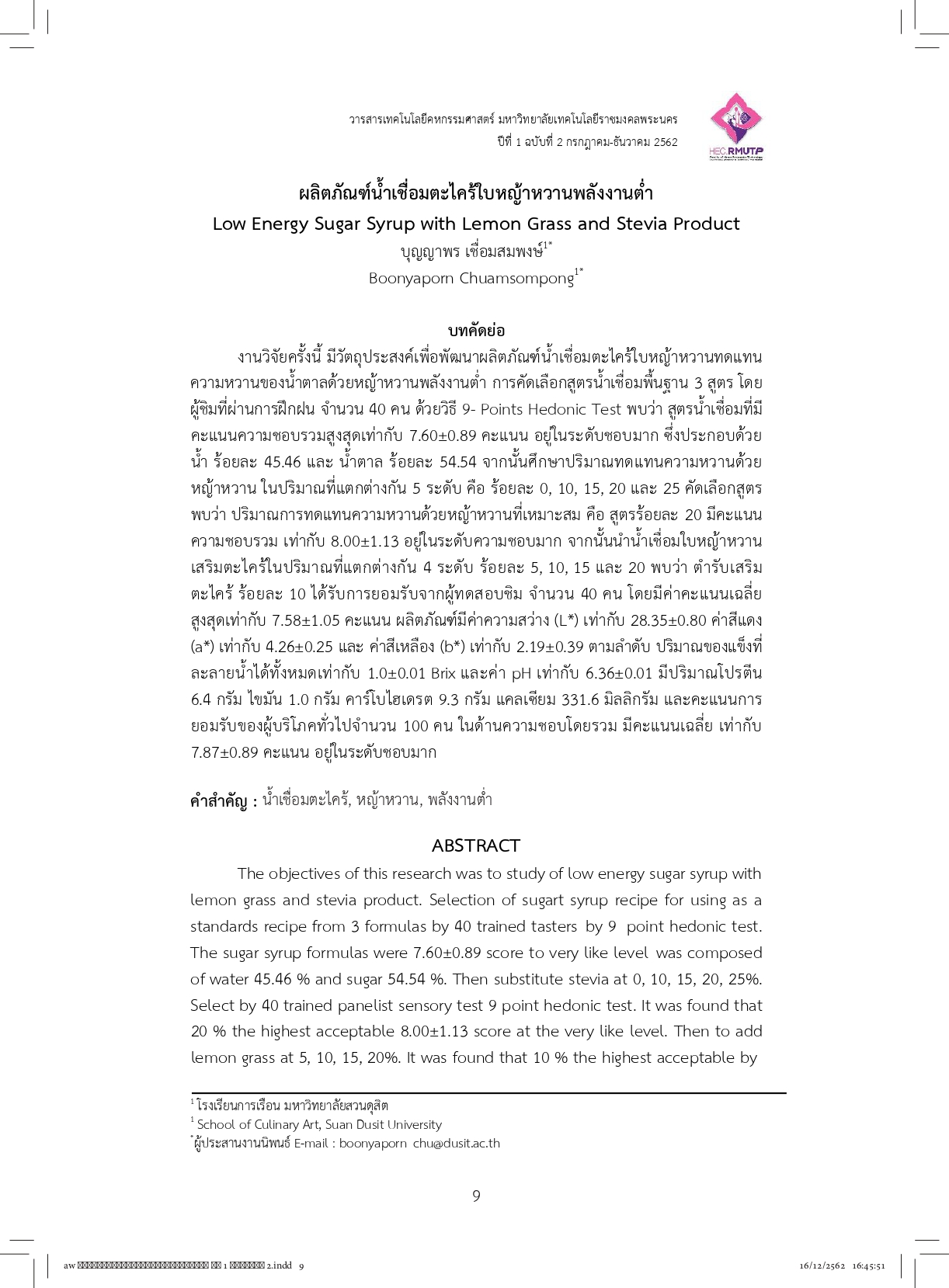ผลิตภัณฑ์น้ำเชื่อมตะไคร้ใบหญ้าหวานพลังงานต่ำ
Main Article Content
บทคัดย่อ
งานวิจัยครั้งนี้ มีวัตถุประสงค์เพื่อพัฒนาผลิตภัณฑ์น้ำเชื่อมตะไคร้ใบหญ้าหวานทดแทน ความหวานของน้ำตาลด้วยหญ้าหวานพลังงานต่ำ การคัดเลือกสูตรน้ำเชื่อมพื้นฐาน 3 สูตร โดย ผู้ชิมที่ผ่านการฝึกฝน จำนวน 40 คน ด้วยวิธี 9- Points Hedonic Test พบว่า สูตรน้ำเชื่อมที่มี คะแนนความชอบรวมสูงสุดเท่ากับ 7.60-0.89 คะแนน อยู่ในระดับชอบมาก ซึ่งประกอบด้วย น้ำ ร้อยละ 45.46 และ น้ำตาล ร้อยละ 54.54 จากนั้นศึกษาปริมาณทดแทนความหวานด้วย หญ้าหวาน ในปริมาณที่แตกต่างกัน 5 ระดับ คือ ร้อยละ 0, 10, 15, 20 และ 25 คัดเลือกสูตร พบว่า ปริมาณการทดแทนความหวานด้วยหญ้าหวานที่เหมาะสม คือ สูตรร้อยละ 20 มีคะแนน ความชอบรวม เท่ากับ 8.00+1.13 อยู่ในระดับความชอบมาก จากนั้นนำน้ำเชื่อมใบหญ้าหวาน เสริมตะไคร้ในปริมาณที่แตกต่างกัน 4 ระดับ ร้อยละ 5, 10, 15 และ 20 พบว่า ตำรับเสริม ตะไคร้ ร้อยละ 10 ได้รับการยอมรับจากผู้ทดสอบซิม จำนวน 40 คน โดยมีค่าคะแนนเฉลี่ย สูงสุดเท่ากับ 7.58-1.05 คะแนน ผลิตภัณฑ์มีค่าความสว่าง (L*) เท่ากับ 28.35-0.80 ค่าสีแดง (a*) เท่ากับ 4.26+0.25 และ ค่าสีเหลือง (b*) เท่ากับ 2.19-0.39 ตามลำดับ ปริมาณของแข็งที่ ละลายน้ำได้ทั้งหมดเท่ากับ 1.0:0.01 Brix และค่า pH เท่ากับ 6.36-0.01 มีปริมาณโปรตีน 6.4 กรัม โซมัน 1.0 กรัม คาร์โบไฮเดรต 9.3 กรัม แคลเซียม 331.6 มิลลิกรัม และคะแนนการ ยอมรับของผู้บริโภคทั่วไปจำนวน 100 คน ในด้านความชอบโดยรวม มีคะแนนเฉลี่ย เท่ากับ 7.87-089 คะแนน อยู่ในระดับชอบมาก
Article Details
เอกสารอ้างอิง
นันทวัฒน์ วิชัยคุ้ม. (2559). 101 sangrias & pitcher Drinks 2556.Mixologist salt bar & restaurant.
ปิยวรรณ ศุภวิทิตพัฒนา.(2555).ดันมาตรการเก็บภาษีกินหวานพบคนไทยบริโภคน้ำตาล 25 ช้อนชา/วัน.
ไพโรจน์ วิริยจารี. (2545). ประเมินทางประสาทสัมผัส.สาขาวิชาเทคโนโลยีการพัฒนาผลิตภัณฑ์อุตสาหกรรม. คณะอุตสาหกรรมเกษตร. มหาวิทยาลัยเชียงใหม่. เชียงใหม่.
สาโรจน์ ศิริศันสนียกุล. (2541). หญ้าหวานสตีเวีย.วารสารส่งเสริมเทคโนโลยีการเกษตร,25(139),160-163.
สุดารัตน์ หอมหวล. (2562). ฐานข้อมูลเครื่องยาสมุนไพร. สืบค้นเมื่อวันที่ 20 มกราคม 2562, จาก http://www.thaicrudedrug.com.
สำนักงานกองทุนสนับสนุนการสร้างเสริมสุขภาพ (สสส.). สืบค้นเมื่อวันที่ 20 มกราคม 2562, จาก http://www.thaihealth.or.th, ค้นเมื่อ 20 มกราคม 2562.
CaboJ, Crespo ME, Jimenez J and Zarzvelo A.(1986).The activity of the major components of their essential oils. The spasmolytic activity of various aromatic plants from the province of granada. I. Plant Med Phytother, 203, 213-218.
Evans BK and James KC and Luscombe DK. (1978). Quantitatives structure-activity relationships and carminative activity. J Pharm Sci, 67, 277.
Haginiwa J, Hasada M and Morishita I. (1963). Properties of essential oil components of aromatics and their phamacological effect on mouse intestine. Pharmacological studies on crude grugs. VII. Yakugaku Zasshi, 83, 624.
Honda G, Koga K, Koezuka Y and Tabata M. (1984). Antidermatophytic compounds of Perilla frutescens Branton var. Crispa decne. Shoyakugaku Zasshi, 238(1), 127-130.
Inouye S, Goi H, Miyauchi K, Muraki S, Ogihara M and Iwanami Y. (1983). Inhibitory effect of volatile constituents of plants on the proliferation of bacteria-antibacteria activity. J Antibact Antifungal Agents, 11(11), 609-615.
Koyama. E., Sakai, N., Ohori, Y., Kitazawa, w., Izawa, O., Kakegawa, K., Fujino, A., and Ui, M. (2003). Absorption and metabolism of glycosidic sweeteners of stevia mixture and their glycosidic sweeteners of steviol in rats and humans. J. Food and Chemical Toxicology, 41(6), 875-883.
Megalla SE, El-Kelltawi NEM and Ross SA. (1980). A study of antimicrobial action of some essential oil constituents. Herba Pol, 26(3), 181-186.
Onawunmi GO. (1989). Evaluation of the antimicrobial activity of citral. Dept Pharm Obafemi Awolowo Univ Nigeria. Lett Appl Microbiol, 9(3), 105-108.
Prakash S, Sinha GK and Pathak RC. (1972). Antibacterial and antifungal properties of some essentials oils extracted from medicinal plants of the kumaon region. Indian Oil Soap J, 379, 230-232.
Ross MSF and Brain KK. (1977). An introduction to phytopharmacy. London: Pitman Medical Publishing Co. Ltd.
Yamada, A., Ohgaki, S., Noda, T. and Shimiza, M. (1985). Chronic toxicity study of dietary stevia extracts in F344 rats. J. Food Hyg. Soc. Japan, 26(2), 169-183.


